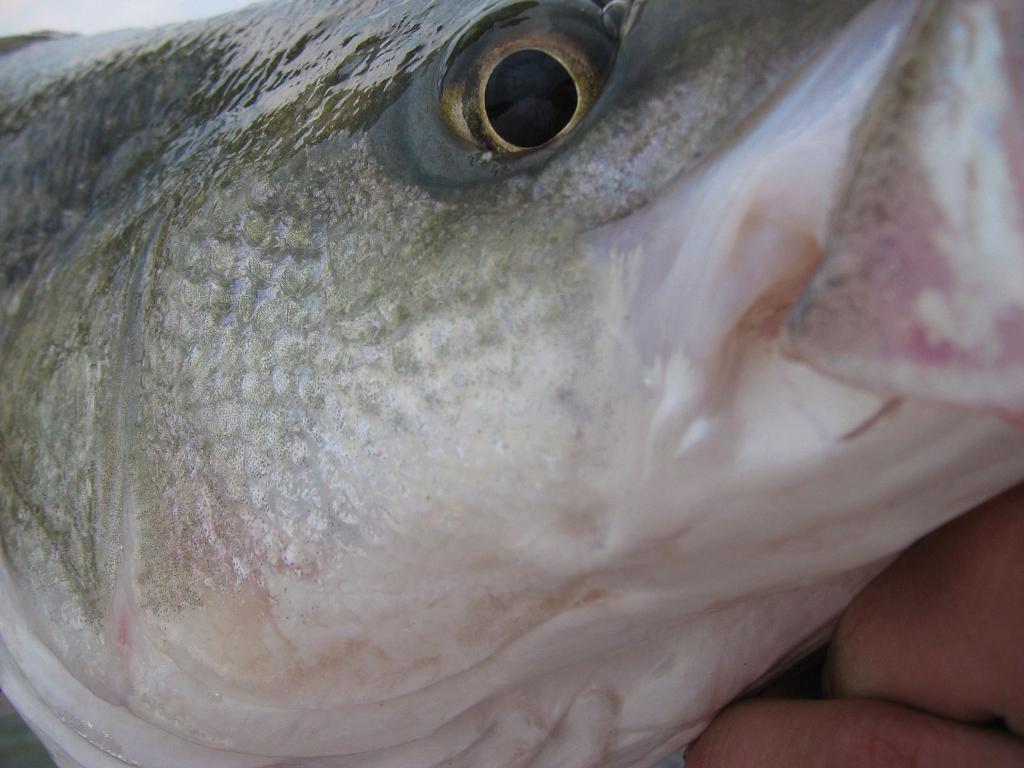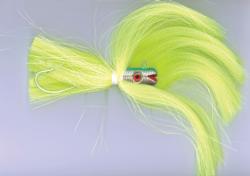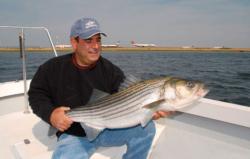Fishing for cows
Trophy saltwater stripers are a supreme angling challenge

Dan Wood was on fish, but he and his two partners were having a problem. The three anglers of Team Atlantic Outboard were taking part in the 2006 Wal-Mart FLW Striper Series tournament in West Dennis, Mass., and just couldn’t get a fish in the boat that fell within the 28- to 34-inch slot limit. It was a problem Wood would have been thrilled to face any other day, but the tournament rules were different. Almost all the fish he caught had to go back – but it wasn’t because they were too small.
“Just about everything we caught was over the slot limit – way over,” Wood recalled. “Some of the fish we were catching were 40 and 45 pounds. It was pretty incredible.”
For some anglers, there are two kinds of striped bass: those over 34 inches and everything else. Bigger is better, but finding the biggest stripers in any region is more a matter of skill than luck. Sure, recreational anglers who simply target any striper tie into giants on occasion. Others, like Wood, rely more on a lifetime of knowledge and experience to find and catch big bass. For them, a 40-pound fish is the pinnacle of saltwater angling.
The numbers game
It’s important to understand that 30-, 40- or 50-pound stripers are relatively rare creatures. Fishing pressure is intense up and down the entire East Coast by both recreational and commercial anglers, and liberal limits and long seasons tend to put a sizeable dent in the bass population as a whole. Everyone wants to catch a big striper, and when sport fishermen do catch a trophy, they often keep it. Due to fishing and natural mortality, the overall number of bass 10 years old and older is a small fraction of the rest of the population. It has been suggested the percentage of striped bass 10 years old and older along the Atlantic Coast is just less than 5 percent.
Right place, right time
Because the biggest stripers are typically females, the most important factor in some regions is simply being in the right place at the right time. For Captain Phil Gootee II, a Chesapeake Bay charter captain and captain of the winning team at the 2006 FLW Striper Series event held at Cambridge, Md., that means spring and fall on his home water. In April and May, cow striped bass are pushing up the Chesapeake on their way to traditional spawning grounds. Once they finish, they head back down the  Bay to the ocean before turning north toward their summer grounds along the New England coast. When they leave, the only fish that remain are smaller females and males. Therefore, to catch those big fish, you have to be there when they are passing through.
Bay to the ocean before turning north toward their summer grounds along the New England coast. When they leave, the only fish that remain are smaller females and males. Therefore, to catch those big fish, you have to be there when they are passing through.
“Those big cows don’t hang around very long after they finish spawning, but they do feed heavily on their way out of the Bay,” Gootee said. “We also get a good fall run when the fish migrate back south in November and into December. They will come back up the Bay following the menhaden for a couple of weeks and then head back out.”
Prime time in the spring is when the water temperature is around 60 degrees. Of course, fishing seasons dictate when Gootee can and can’t fish, but that prime water temperature typically falls during the open spring season.
“For me, 60 is a good, round number. That doesn’t mean you can’t catch them in cooler water or warmer water, but they don’t show up in great numbers until it gets up around that 60-degree mark – at least not where I fish,” Gootee said.
New England anglers, however, have the luxury of a long window of opportunity on the largest fish. Once they reach their summer haunts along the New York and New England coasts, huge stripers settle in and stay for months, often well into October. After that, they head south again. That’s when Southern anglers like Gootee switch tactics again and go after those big fish. Virginia and North Carolina anglers typically have their best shot at a monster in the winter, when big schools of 20-, 30- and 40-pounders spend the season gorging on menhaden just off the coast.
Deep thinking … sometimes
Where Gootee fishes, the largest bass tend to hang around deep channels in the main sections of the bay, but they will move up to shallower structure like rocks and sand bars to feed. Mostly, however, they follow schools of bait over open water, hanging under the bait, which often travels near main channels. Gootee trolls umbrella rigs along the edges of those main channels, particularly in areas with sharp, defined ledges. Although he will run parallel to the channel itself, he has the most success by trolling across them in a zigzag pattern, which seems to put the baits in front of more fish.
“We’ll troll higher in the water column and faster in the spring because I think the fish are just more active and eager to feed then,” he said. “However, in the fall, we do best with our baits down deep. In order to get down to them, we have to troll a little slower, although some guys simply add more weight. I just like to go a little slower.”
Deep may be the rule, but every rule has exceptions. During the tournament in West Dennis, Mass., Dan Wood and his team put their boat in just a few feet of water within casting distance of the beach. It was midday and the men were casting big surface plugs to the shallow rocks near the surf. They caught a lot of fish, but only a few of them fell within the 28- to 34-inch tournament slot limit.
 “Just about everything we caught was over that maximum size limit; some were way over,” Wood said.
“Just about everything we caught was over that maximum size limit; some were way over,” Wood said.
The tactic they used, topwaters in shallow water, went against conventional wisdom, but it worked, nonetheless. Wood was catching fish up to 45 pounds in 5 feet of water in the middle of a hot, sunny day. Even he was surprised; proof that fish sometimes don’t follow the rules anglers set for them.
“We do well on bigger fish in shallow water typically early in the morning and on overcast days,” Wood noted. “They come up to feed around those shallow rocks and then go deep during the day. I’m not sure why those big bass were up there under those conditions, but they were there in good numbers.”
Michael Deskin, a guide and part of Team Tara Anne, which won the FLW Striper Series event in Westbrook, Conn., last year, also targets monster stripers in shallow water under low-light conditions. When he’s working as a guide, he wants to be on the water well before sunrise to catch those big fish around shallow structure. On a typical day, however, he probes deep water, up to 50 feet, in search of trophy-class bass. The water he fishes – Long Island Sound and the coast of western Connecticut – has many deep humps and ridges, which are prime places to target stripers.
“It pretty much never fails when I drift up and over one of those peaks that I’ll hook bigger fish on the deep side of the drop-off,” Deskin said. “The smaller fish tend to stay up high, but the bigger ones stay down out of the stronger current. Maybe they are lazier than smaller ones, or maybe they are less capable of competing with the younger, faster fish, so they simply stay out of their way.”
Both Deskin and Wood agreed bigger bass will stake out a home territory around shallow rocks, but they are often easier to catch around deep structure. Gootee also prefers to fish deep for the basic fact that big stripers are much more boat shy than smaller ones. When he does catch them close to the surface, it’s usually by putting the baits as much as 400 feet behind the boat.
“They tend to be real spooky in shallow water,” Wood added. “I’ve actually seen them take off when we pull a lure from behind them. It’s real important not to do that because I don’t think any baitfish in its right mind would swim up behind a striper. It’s not natural.”
Gootee also catches bigger fish down deep, but primarily in the fall when trophy-sized stripers tend to hug the bottom. He pulls the same umbrella rigs, but he tends to pull them a little slower to get them down close to the bottom. He also finds larger fish under schools of smaller fish, which is something Deskin has also noticed in his area.
“It can be difficult to get a bait down past those smaller fish, but if you can, you stand a good chance of hooking a bigger bass,” Gootee noted.
Bigger is better
 If there’s one thing striper experts agree on, it’s that big fish favor big baits. For Deskin, it’s not necessarily because cow stripers won’t eat a smaller bait. In fact, he routinely catches trophy-class bass on 4- and 6-ounce parachute rigs. He uses big, live menhaden for the simple fact that smaller stripers tend to avoid them because they just can’t get their mouths around such big baits.
If there’s one thing striper experts agree on, it’s that big fish favor big baits. For Deskin, it’s not necessarily because cow stripers won’t eat a smaller bait. In fact, he routinely catches trophy-class bass on 4- and 6-ounce parachute rigs. He uses big, live menhaden for the simple fact that smaller stripers tend to avoid them because they just can’t get their mouths around such big baits.
What does he consider big? Deskin favors bunker anywhere from 12 to 16 inches. Of course, live bait isn’t legal during FLW Striper Series tournaments, but recreational anglers can use it, as long as regulations allow it.
“You won’t catch a lot of fish on those great-big baits, but the ones you catch tend to be real big,” Deskin said.
Wood agreed. Although he generally favors artificials, he follows the same tenet as Deskin – big baits equal big bass. His favorite tactics include trolling with 12- or 14-inch spoons rigged on wire line, which helps get the baits down deep. Huge spoons imitate a large herring or menhaden and help eliminate smaller fish.
David Dudley also has a clear grasp of that notion. As a saltwater captain who pursues striped bass off the coast of North Carolina, as well as a current fixture as a Team Castrol pro on the Wal-Mart FLW Tour, he knows what makes fish tick.
“Stripers aren’t any different than largemouths in that sense. Big fish of both species favor bigger baits,” Dudley said. “That doesn’t mean you can’t catch 30- or 40-pound stripers or 8- or 10-pound largemouths on small baits, but a big bait will definitely get their attention more than a smaller lure.”
That’s why he throws an oversized swimbait when he wants to target bigger striped bass. Where he fishes – the inshore waters around Nags Head – stripers don’t necessarily swim in segregated schools. That is, big fish will be feeding right alongside smaller fish. To eliminate those smaller stripers, Dudley heaves a 12-inch swimbait right into the schools of stripers that hang around the coast of North Carolina. Of course, the monster stripers will typically be in New England throughout the summer and early fall, but that big bait will often catch the biggest bass where he fishes.
Consistently catching trophy fish of any species is always a different game than simply landing keepers. Trophies generally require bigger baits, detailed presentations and, universally, a lot more patience. A giant saltwater striper, given its seasonal movements and overall rarity, is certainly a fish to be revered.